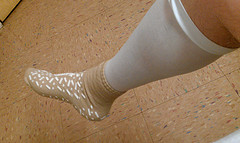The Real Danger of Flying? DVT, also known as Economy Class Syndrome
22 March 2012
March is deep vein thrombosis (DVT) awareness month and we thought it a good time to discuss the dangers. Air travelers who are in a situation of prolonged immobility are particularly at risk, which is why it’s also known as ‘Economy Class Syndrome’ although first class passengers have just as much risk.
DVT occurs when an abnormal blood clot forms in a large vein – typically in the lower leg, thigh, or pelvis, but they can also occur in the arms. Recent statistics from the Centers for Disease Control (CDC) indicate that between 60,000 and 100,000 Americans die each year from DVT (source: https://www.cdc.gov/ncbddd/dvt/data.html).
Some unfortunate recent deaths are making the public more aware of the dangers of DVT, including:
- Rapper Heavy D, who died from a pulmonary embolism caused by DVT after a flight from London to L.A.
- Chris Staniforth, a young man who played video games for up to 12 hours
Signs and Symptoms of Deep Vein Thrombosis (DVT)
DVT can cause a life-threatening complication called pulmonary embolism (PE) where part or all of the clot breaks loose and travels through the bloodstream and into the lungs where it can cause:
- Sudden shortness of breath
- Chest pain or pressure
- Coughing up blood
- Sudden collapse
- Even sudden death
Because of the isolated and general pain, DVT is sometimes dismissed as a pulled muscle which can delay diagnosis, but it often causes the following symptoms, which can be early indicators of the danger:
- Swelling and/or redness isolated to a particular limb
- Unexplained pain or tenderness in the limb
- Skin that is warm to the touch in a patient’s limb
Unfortunately, some people with DVT have no symptoms at all.
Prevention of Deep Vein Thrombosis (DVT)
The primary key to prevention is movement, but in general preventative steps include some well-known suspects:
- Maintaining a healthy body weight
- Exercising regularly
- Not smoking or quitting smoking
- Drinking plenty of water
- Limiting alcohol and caffeine intake
But exercising – even when you are in a situation of forced immobility – is still the best prevention.
When you are traveling in a plane, train, car, or other travel conveyance, this means:
- getting up and walking around every 1-2 hours
- standing and sitting repeatedly if you can’t move from your seat
- calf exercises, such as raising your heels off the floor over and over
- fidgeting and jumping your feet
- moving your feet in circles to circulate the blood from the ankles
Luckily, because more people are becoming aware of the risks of DVT and so your wriggling and jumping about should irritate them less. Try not to bump or jostle your neighbor too much – economy class is really tight. With a little effort, you may even be able to entice them to join you. Can you imagine an entire plane of people doing the wave?
Damian Tysdal is the founder of CoverTrip, and is a licensed agent for travel insurance (MA 1883287). He believes travel insurance should be easier to understand, and started the first travel insurance blog in 2006.

